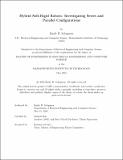Hybrid Soft-Rigid Robots: Investigating Series and Parallel Configurations
Author(s)
Sologuren, Emily R.
DownloadThesis PDF (17.16Mb)
Advisor
Rus, Daniela
Terms of use
Metadata
Show full item recordAbstract
The diverse set of traits that soft-rigid robots possess have the potential to be applied towards a multitude of applications that require both strength and flexibility. This thesis looks at two kinds of soft-rigid robotic systems: the first is a series assembly of soft-rigid modules with stiffness modulation to form a soft-rigid robotic arm, and the second system is a parallel assembly of rigid bones casted into silicone to form a passive soft-rigid flipper for a robotic sea turtle. We first introduce a new class of soft-rigid modules that can modulate their stiffness on a continuum through tendon-driven actuation and the integration of "soft" and "rigid" components. Their serial assembly form a self-standing, soft-rigid robotic arm (SRRA). When coupled with an adapted soft PD+ controller, we generate trajectories that demonstrate the manipulator’s ability to deform for maneuvering tasks and stiffen for load-bearing tasks. The robotic sea turtle’s parallel, soft-rigid flippers emulate those of its animal counterpart. To leverage this structure for underwater locomotion, we look at a CPG-coupled reinforcement learning framework to optimize for a forward swimming gait.
Date issued
2024-05Department
Massachusetts Institute of Technology. Department of Electrical Engineering and Computer SciencePublisher
Massachusetts Institute of Technology